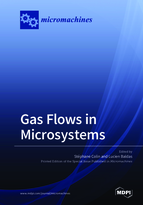Gas Flows in Microsystems
A special issue of Micromachines (ISSN 2072-666X). This special issue belongs to the section "A:Physics".
Deadline for manuscript submissions: closed (31 January 2019) | Viewed by 57567
Special Issue Editors
Interests: microfluidics; gas microflows; fluidic microsystems; microscale heat transfer
Special Issues, Collections and Topics in MDPI journals
Interests: microfluidics; gas microflows; fluidic microsystems; particle-laden microflows
Special Issues, Collections and Topics in MDPI journals
Special Issue Information
Dear Colleagues,
The last two decades have witnessed a rapid development of micro-electro-mechanical systems (MEMS) involving gas microflows in various technical fields. Gas microflows can for example be observed in micro heat exchangers designed for chemical applications or for cooling of electronic components, in fluidic micro-actuators developed for active flow control purposes, in micronozzles used for the micropropulsion of nano and picosats, in micro gas chromatographs, analyzers or separators, in vacuum generators and in Knudsen micropumps, as well as in some organs-on-a-chip such as artificial lungs. These flows are rarefied due to the small MEMS dimensions and the rarefaction can be increased by low pressure conditions. The flows relate to the slip flow, transition or free molecular regimes, and can involve monatomic or polyatomic gases and gas mixtures. Hydrodynamics and heat and mass transfer are strongly impacted by rarefaction effects and temperature driven microflows offer new opportunities for designing original MEMS for gas pumping or separation. Accordingly, this Special Issue seeks to showcase research papers, short communications, and review articles that focus on novel theoretical and numerical models or data, as well as on new experimental results and technics, for improving knowledge on heat and mass transfer in gas microflows. Papers dealing with the development of original gas MEMS are also welcome.
We look forward to receiving your submission.
Prof. Stéphane Colin
Dr. Lucien Baldas
Guest Editors
Manuscript Submission Information
Manuscripts should be submitted online at www.mdpi.com by registering and logging in to this website. Once you are registered, click here to go to the submission form. Manuscripts can be submitted until the deadline. All submissions that pass pre-check are peer-reviewed. Accepted papers will be published continuously in the journal (as soon as accepted) and will be listed together on the special issue website. Research articles, review articles as well as short communications are invited. For planned papers, a title and short abstract (about 100 words) can be sent to the Editorial Office for announcement on this website.
Submitted manuscripts should not have been published previously, nor be under consideration for publication elsewhere (except conference proceedings papers). All manuscripts are thoroughly refereed through a single-blind peer-review process. A guide for authors and other relevant information for submission of manuscripts is available on the Instructions for Authors page. Micromachines is an international peer-reviewed open access monthly journal published by MDPI.
Please visit the Instructions for Authors page before submitting a manuscript. The Article Processing Charge (APC) for publication in this open access journal is 2600 CHF (Swiss Francs). Submitted papers should be well formatted and use good English. Authors may use MDPI's English editing service prior to publication or during author revisions.
Keywords
- gas microflows
- rarefied flows
- microscale heat and mass transfer in gases
- gas MEMS
- theoretical, experimental and numerical analysis
Related Special Issue
- Gas Flows in Microsystems, Volume II in Micromachines (6 articles)








